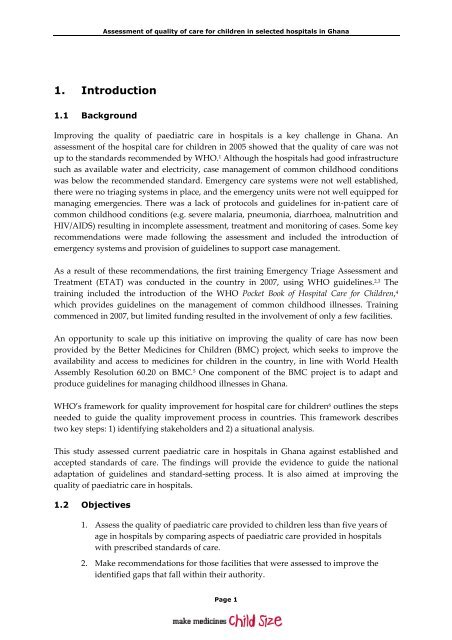Assessment of quality of care for children in selected hospitals in ...
Assessment of quality of care for children in selected hospitals in ...
Assessment of quality of care for children in selected hospitals in ...
You also want an ePaper? Increase the reach of your titles
YUMPU automatically turns print PDFs into web optimized ePapers that Google loves.
<strong>Assessment</strong> <strong>of</strong> <strong>quality</strong> <strong>of</strong> <strong>care</strong> <strong>for</strong> <strong>children</strong> <strong>in</strong> <strong>selected</strong> <strong>hospitals</strong> <strong>in</strong> Ghana1. Introduction1.1 BackgroundImprov<strong>in</strong>g the <strong>quality</strong> <strong>of</strong> paediatric <strong>care</strong> <strong>in</strong> <strong>hospitals</strong> is a key challenge <strong>in</strong> Ghana. Anassessment <strong>of</strong> the hospital <strong>care</strong> <strong>for</strong> <strong>children</strong> <strong>in</strong> 2005 showed that the <strong>quality</strong> <strong>of</strong> <strong>care</strong> was notup to the standards recommended by WHO. 1 Although the <strong>hospitals</strong> had good <strong>in</strong>frastructuresuch as available water and electricity, case management <strong>of</strong> common childhood conditionswas below the recommended standard. Emergency <strong>care</strong> systems were not well established,there were no triag<strong>in</strong>g systems <strong>in</strong> place, and the emergency units were not well equipped <strong>for</strong>manag<strong>in</strong>g emergencies. There was a lack <strong>of</strong> protocols and guidel<strong>in</strong>es <strong>for</strong> <strong>in</strong>‐patient <strong>care</strong> <strong>of</strong>common childhood conditions (e.g. severe malaria, pneumonia, diarrhoea, malnutrition andHIV/AIDS) result<strong>in</strong>g <strong>in</strong> <strong>in</strong>complete assessment, treatment and monitor<strong>in</strong>g <strong>of</strong> cases. Some keyrecommendations were made follow<strong>in</strong>g the assessment and <strong>in</strong>cluded the <strong>in</strong>troduction <strong>of</strong>emergency systems and provision <strong>of</strong> guidel<strong>in</strong>es to support case management.As a result <strong>of</strong> these recommendations, the first tra<strong>in</strong><strong>in</strong>g Emergency Triage <strong>Assessment</strong> andTreatment (ETAT) was conducted <strong>in</strong> the country <strong>in</strong> 2007, us<strong>in</strong>g WHO guidel<strong>in</strong>es. 2,3 Thetra<strong>in</strong><strong>in</strong>g <strong>in</strong>cluded the <strong>in</strong>troduction <strong>of</strong> the WHO Pocket Book <strong>of</strong> Hospital Care <strong>for</strong> Children, 4which provides guidel<strong>in</strong>es on the management <strong>of</strong> common childhood illnesses. Tra<strong>in</strong><strong>in</strong>gcommenced <strong>in</strong> 2007, but limited fund<strong>in</strong>g resulted <strong>in</strong> the <strong>in</strong>volvement <strong>of</strong> only a few facilities.An opportunity to scale up this <strong>in</strong>itiative on improv<strong>in</strong>g the <strong>quality</strong> <strong>of</strong> <strong>care</strong> has now beenprovided by the Better Medic<strong>in</strong>es <strong>for</strong> Children (BMC) project, which seeks to improve theavailability and access to medic<strong>in</strong>es <strong>for</strong> <strong>children</strong> <strong>in</strong> the country, <strong>in</strong> l<strong>in</strong>e with World HealthAssembly Resolution 60.20 on BMC. 5 One component <strong>of</strong> the BMC project is to adapt andproduce guidel<strong>in</strong>es <strong>for</strong> manag<strong>in</strong>g childhood illnesses <strong>in</strong> Ghana.WHO’s framework <strong>for</strong> <strong>quality</strong> improvement <strong>for</strong> hospital <strong>care</strong> <strong>for</strong> <strong>children</strong> 6 outl<strong>in</strong>es the stepsneeded to guide the <strong>quality</strong> improvement process <strong>in</strong> countries. This framework describestwo key steps: 1) identify<strong>in</strong>g stakeholders and 2) a situational analysis.This study assessed current paediatric <strong>care</strong> <strong>in</strong> <strong>hospitals</strong> <strong>in</strong> Ghana aga<strong>in</strong>st established andaccepted standards <strong>of</strong> <strong>care</strong>. The f<strong>in</strong>d<strong>in</strong>gs will provide the evidence to guide the nationaladaptation <strong>of</strong> guidel<strong>in</strong>es and standard‐sett<strong>in</strong>g process. It is also aimed at improv<strong>in</strong>g the<strong>quality</strong> <strong>of</strong> paediatric <strong>care</strong> <strong>in</strong> <strong>hospitals</strong>.1.2 Objectives1. Assess the <strong>quality</strong> <strong>of</strong> paediatric <strong>care</strong> provided to <strong>children</strong> less than five years <strong>of</strong>age <strong>in</strong> <strong>hospitals</strong> by compar<strong>in</strong>g aspects <strong>of</strong> paediatric <strong>care</strong> provided <strong>in</strong> <strong>hospitals</strong>with prescribed standards <strong>of</strong> <strong>care</strong>.2. Make recommendations <strong>for</strong> those facilities that were assessed to improve theidentified gaps that fall with<strong>in</strong> their authority.Page 1
















